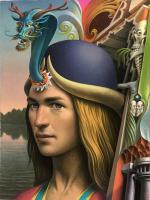
In my painting the youth has woken from his trance. At his shoulder is Nemesis (or maybe Echo). The Dragon emerging from his forehead represents his awakening- awareness of a world outside himself. Perhaps the dragon came to him from the depth of the waters.
He wears a horned helmet like an Assyrian Genius- one class of which seem to have been born as human beings and then transfigured in the sweet waters of the Abyss. On his left is the enclosed and interior Self from which he has emerged, on his right is the landscape and still water that gave him self-knowledge.
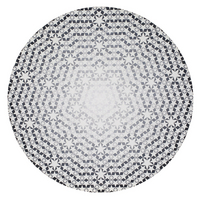
NATURE
This painting is an examination of my discovery of the infinite, radiant and unpredictably repeatative pattern that will arise from a single, central pentagon. A friend suggested this was a visual form of an irrational number. He was probably right but I would call it “super rational” because the ordered quality of the arising pattern is obvious to any observer but at the same time it’s form unfolds past the enclosure of human conception.
Some time after producing this painting I learned that a physicist (Roger Penrose) found the same basic pattern circa 1970. He suggested somewhere that this form was probably known to Islamic geometers. I’m sure he is correct and further I imagine it was probably known in Ancient Greece, Egypt and Sumeria. Maybe people knew about it an hundred thousand years ago. One day the pattern simply appeared in my mind, it seemed like Nature at work. I’m sure it has appeared to others before.
The painting was laid out with a compass and a straight edge and painted with a brush in acrylic.
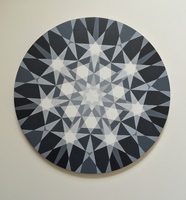
GRAIL KEEP
In it’s beginning this painting was an exploration of the strange fact that a heptagonal division of space for some reason seems to produce (or at least suggest) hexagrams. The design grew by interlocking and overlapping of linear and planar extensions from the central construction: the seven- pointed star surrounded by six- pointed stars.
As work progressed, I kept thinking of something I had once heard (I don’t know where). Somewhere in a forest in Saxony there is a hidden castle. At the innermost interior of the castle there is a room called the Grail Keep. At the center of the room sits The Holy Grail surrounded by seven sages and seven knights. The sages speak to the grail and the knights protect it.
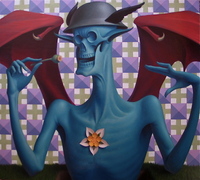
DEATH MERCHANT
For more than a year in my early adulthood it was a common (often daily) occurrence that I would fall into a trance and have visions. The visions were like dreams but much more real. They were much like the contents of the books of The Prophets in the Bible and especially like those of the Book of Revelations.
in one of these visions I was pulled from my bed by a pack of horrible creatures- part jackal, part bat- down the stairs and into a rocky chute down which I tumbled for excruciating miles until I landed in a gigantic, city sized underground cavern. It was filled beyond counting with shaded beings that I took to be damned souls and demons mixed in a crowd. All were facing toward the center of the cavern where, towering like a mountain, was the devil himself. He looked very much like Dante’s description- buried to the waist with great leather wings and frightening as a volcano. Then suddenly I could see myself- I was pure and bright like a single star in a black sky. He saw me too and turned his face to me.
Death Merchant started as a representation of my vision but quickly became something else. His helmet is like those worn by British soldiers in the first world war, and also like the helmet of Mercury- but with crow’s wings. He holds an opium bulb which as though it were a lollipop or maybe a microphone. On his chest is an heraldic rose- like superman’s emblem. He stands in a freshly dug grave and behind him is displayed a pattern of crosses and pyramids.
UP FROM THE SEA
This is one of the first serious paintings I made. It connects to a strange experience I had once while swimming in the seaway next to my family's house. As I was walking up out of the water I felt the presence of a being, some aquatic divinity like Dagon or Neptune- an intelligence and a power- it was a bit frightening and strange.
Why does he have an elongated face? It is certainly his face and not his head that is stretched. What is emphasized here is not his mind but rather his senses. He looks and smells and hears the world. It does not matter what he thinks about the world- it matters that he experiences it. For this reason he is immersed in water, whence comes all life. He is alive and in the world.
He looks away from the band of modulated color that shares space with him. It is his intellectual sky, his mind- note the star that hovers high. The star has no dimension but radiates energy in an empty sky. His body is green gold like the color of first shoots in spring. It is the color of potential. Maybe he is a form of the Green Man.
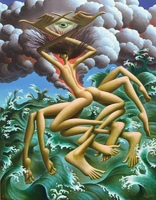
NAMAKA'S FLOOD
There was not much thought about the meaning of the painting until it was almost finshed. I had considered it a picture of a Celtic sea goddess or maybe Aphrodite being born in the foam. One form of her myth has it that the god Chronus (Time?) castrated his father Uranus (Eternity) and threw the old man’s testicles into the sea. From the testicles a steaming foam rose up which gave birth to the Goddess of Love… I don’t know if it’s a true story but maybe one of those male gods is hiding in the cloud. Maybe the myth recalls the interaction of Fire and Water in Island volcanoes.
About midway through the project I started thinking about Pele- the mother and famous volcano- goddess of Hawaii. But as I looked into her myth a bit it seemed to me that this is more like a painting of her sister Namaka the sea goddess coming with the flood to douse the Pele’s volcano in revenge for Pele’s seduction of Namaka’s husband.
The woman in the painting is in a posture that invites the “male gaze”. For her protection against this sort of wicked stare I have given her a disembodied eye between her fingers- it may be significant of a male protector- a storm god in the clouds (as Aphrodite might expect the protection of her father Zues or her husband who dwells in the volcano).
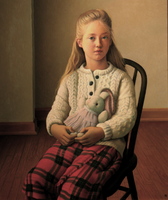
AMELIA AND BUNNY
This was the first and one of few formal portraits I have made. The subject is the daughter of two very excellent people who I was lucky enough to meet in the first year of the new millenneum. They were very patient with an artist who, being very unshure of himself, took too long to complete this painting. Amelia and bunny also showed considerable patience.
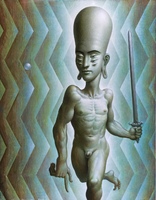
SHAOSING KNOBSTIJL
The figure in this painting is like the popular but at the same time oddly obscure Taoist god called “Longevity Star”. Apparently he was an historical figure born bald and grey like an old man and with a huge head. Without any certain intention I’ve conflated his image with that of another Taoist god- the sword master Lu Dongbin. The iconography is further conflated with that of the muscular guardians of the Buddha AND that of Argus- the many eyed watchman of Hera’s garden. This is a syncretic construction but not a preconceived one, the figure took form in the course of work.
It is hard to say what the picture means because the meaning is tied up in the making of the thing. In other words the figure, part by part, took on it’s form so that it could produce an effect on the inner life of the artist. I can however say that his pursuit of the pearl (upper left) is significant. It seems from his gesture he would bring it to heel which indicates either that he has foolishly superstitious/ animistic beliefs or maybe that he knows something about pearls that most people don’t.
“Knobstijl” is a Lowlands term for the depiction of knobbed muscular forms. In my understanding it was coined to describe some of the engravings of H. Goltzuis.
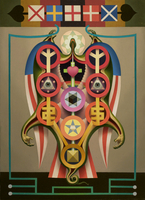
Anyone familiar with occult or mystical imagery will immediately recognize that the design of this piece is based on the Sepher Yetzirah. I used the traditional “spheres and pillars” of the famed diagram as a beginning point but did not adhere to any other preexistent scheme. I added flag like color arrangements and then actual flags to fill out the picture. The picture is made as a form of contemplation- it does not present defined symbols, it is not a specific statement or a collection of precise ideas.
The figure - it has hands and feet as well as wings and a tail- is a dragon angel. It is a conflated image like the those in the book of revelation- the Son of Man and the Son of Morning. Is it America and China? The dragon is flayed like the serpent represented in the form of the ceremonial boat found at Osberg, Norway. Inside is the tree- the makings of a mast and sails? But see- the serpent is flayed by it’s own heart for that organ holds the pure, silvery white sword of spirit. It is the will to live that goes beyond the boundaries of life.
But what does this “self- opening” reveal to the viewer?
The green line that surrounds the “angel” derives from the appearance of the lines and terminals on a computer’s memory board. Below, the lines form an emblem of the sacred syllable “AUM” which, it is said, creates the universe. Above, the line is broken by the hands of the dragon/ angel who takes hold of these channels bounding creation and breaks them- a hero splitting the body of the ouroboros and creating an opening through which the soul might leave the imprisoning circle of phenomenal existence and enter the perfect realm of the gods or ancestors.
At the top are the flags of the Anglo/ Nordic settlers who spawned the political entity known as The United States of America. Looming behind are the pan-african colors for the enslaved peoples who were forced to join in the project. The figure of the flayed serpent can also be seen as a turtle whose belly faces the viewer- this double image refers to the great harms done to the native peoples in the establishment and growth of the United States. While the old serpent or turtle has been slain, it has also been dressed with wings and may have gained a new life thereby. The symbol of the spades, or more properly swords, are like that spinning blade wielded by the angel stationed at the gate of eden-- barring entry to fallen humanity until the undoing of Time.
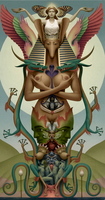
GODDESS OF THE SERPENT TWINS (NEPTHYS RECOMBINANT)
This painting began as a watercolor painted on top of some home made “tie-died paper” given to me by a fellow I met by chance while walking in Berkeley, CA in the summer of 1992. I have never seen him again. The paper served as a sort of Rorshach pattern in which I saw a sort of totemic assembly of images that became the body of the goddess and her serpentine sons.
Viewers familiar with Egyptian art will recognize many forms derived from that tradition. For example, the goddess bears the head of the so-called “Set animal”, an as yet unidentified creature. Perhaps it was a cousin of the pig or anteater that fell into extinction since the ancient period. The pharaonic headdress may be taken to suggest the recent controversy regarding the famous mask of King Tut— now thought by some to have been made originally for Nefertiti.
The symbolic scheme of the painting is complex and willl be left for another time and place. I will say that the symbols are intended primarily to express a feeling and to effect a psycho/ spiritual reconnection to something that became occulted in the development of civilization as we know it. It is, in a name, The Divine Feminine.
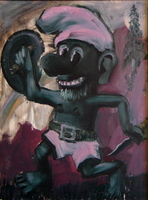
VIKING SMURF
This painting was probably inspired by early memories of Norway and also by my friend Hugh Langtree, an aged Irish cowboy that I used to visit with in Hollywood. He was from Argentina, stood 6’10” and was full of stories about gunfights with cattle rustlers and and various run-ins with the secret police of Peron’s era. He was a tough and spirited man. Viking smurf is a good natured fellow but ready to defend his mountain home should the need arise. He borrows some of the iconography of the nordic Heimdall: herald of Asgard. The heavenly rainbow bridge is displayed behind him as he protects the realm of the gods from profane invaders.